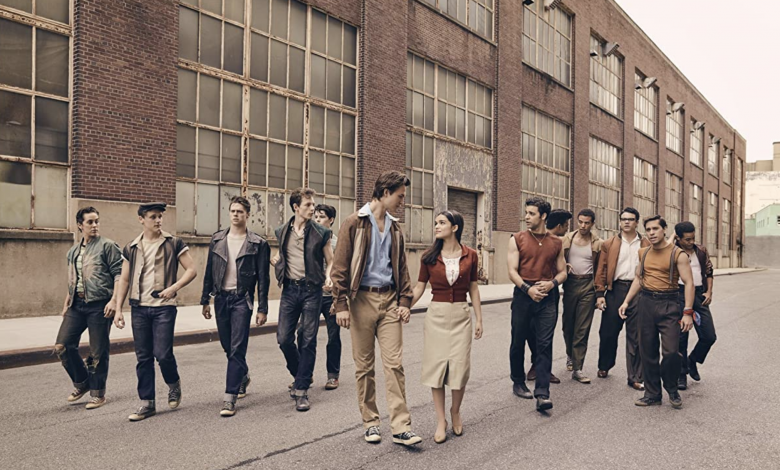West Side Story: A Smart and Sufficient Remake

By Abigail Lee ‘25 / Emertainment Monthly Staff Writer
After a long-delayed premiere, Stephen Spielberg’s West Side Story has arrived to much fanfare and praise. Its enhancements to the original both in cultural sensitivity and reimagination of musical numbers has deemed it an updated version fit for 2021. Indeed, Spielberg’s earnest take on the classic musical aims for a certain expository realism that produces bold triumphs and an unfortunate misstep.
The film sticks closely to the plot of the original musical: on the West Side of Manhattan (specifically San Juan Hill), a white gang called the Jets are engaged in a battle for territory against the Sharks, a gang of Puerto Rican immigrants. A spin on Romeo and Juliet, Maria, the younger sister of the Sharks’ leader Bernardo falls in love with Tony, an ex-Jets member. Bubbling racial tensions overflow into spates of violence as Tony and Maria kindle a taboo relationship in 1950s New York.
The 1961 adaptation by Robert Wise and Jerome Robbins has a controversial legacy for its casting of white actors in brown-face as Puerto Ricans, including Natalie Wood as Maria. The source material itself has undergone speculation. Jerome Robbins, Leonard Bernstein, Stephen Sondheim, and Arthur Laurents sought to devise a rendition of the Shakespearean tragedy and replace the warring families with the ethnic conflicts of New York City. They chose the Puerto Ricans not out of research or even peripheral knowledge but out of happenstance—Stephen Sondheim once said, “I’ve never been that poor and I’ve never even met a Puerto Rican.”
Nonetheless, the musical captured a truth about its time. The increase of immigrants in New York brought a wave of urban tensions and separatist discrimination; the face of New York was changing rapidly, and white fear of shifting turf strongholds was spreading. “America” shines as a presage of the assimilation debate, “Officer Krupke” is a lament of bigoted white youths. In this adaptation, Spielberg’s direction and Tony Kushner’s screenplay make use of the most potent political themes of the original, expanding them into necessary context and characterization, which are disseminated through dialogue and setting.
West Side Story begins with a pan shot over blanched heaps of rubble and dust—San Juan Hill is being converted into the Lincoln Center, and soon the contested territory will no longer belong to either the Jets or the Sharks. “I wake up to everything I know either getting sold, or wrecked, or being taken over by people that I don’t like,” says Riff (Mike Faist), the leader of the Jets. Lt. Schrank (Corey Stoll), who is in charge of seeing the end of the turf war, attributes the Jets’ obstinance to end-of-the-rope ignorance. Every group of white workers has toiled in the pit of the American Dream, except the family clans of the Jets’ whose drunken laziness has deemed them “the last of the can’t-make-it Caucasians.” White resentment and entitlement motivates the Jets—an undertone of the original that is spelled out in this rendition.
The Puerto Rican characters are also given more depth as a lively, genuine community that exists outside of the particular conflict with the Jets. They speak Spanish, which is not translated for the outside observer or subtitled for the audience. When Spielberg transforms “America” from a rooftop number to a streetwide spectacle, it’s obvious he’s reveling in communal vibrancy. Ariana Debose’s fearless Anita carries this scene as she does many others.
Spielberg makes the numbers bigger and brighter, eschewing the intimacy of quieter staging in the 1961 version. There is much more of New York here in locations and visuals. The characters don’t live in the perpetual dark of seedy neighborhoods, as they did in the original; instead, New York is vivacious, alive. Spielberg’s biggest accomplishment is that he, excuse the cliché, establishes the city as its own character. The Jets and Sharks are not the only people in the world—they’re enmeshed in a breathing social history. When the gangs clash, it seems that all of New York becomes enveloped in their tragedy, as the characters’ lives change forever and the city changes with them. Spielberg imbues consequence and grandeur into these quotidian acts of violence.
The film is also hurt by its own expansiveness. The canvas is stretched too far, and the universal romance at the center is less than convincing. Rachel Zegler is a fine Maria, and she captures the character’s sweet, youthful hope. Ansel Elgort, on the other hand, is inexpressive and stale. The miscasting is most obvious in their meeting scene at the gym and in “Tonight.” What is supposed to be spontaneity and inchoate passion becomes timidity and dull flirting. While the original suffered the same problem of miscasting, Wise and Robbins played with lighting and the sense of enclosed space in order to grant the characters more intimacy. Spielberg on the other hand, makes no use of the ability for exteriors to reflect interior emotion. But perhaps this wouldn’t have been an issue had the casting been better.
West Side Story has always been a contemporary tale, no matter when it is told, because of the perennial tension between the past and present. Spielberg’s remake is not particularly exceptional, but it successfully reinforces the timeless themes of this most-beloved musical.